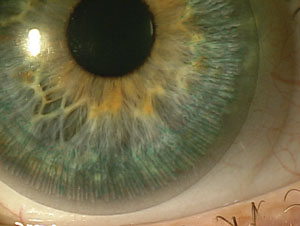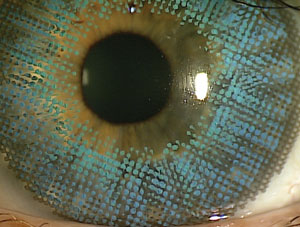But doctors should make a point to stay up-to-date on the new advances in this category. “Those docs willing to break old habits of ‘no one wants colored lenses’ will do great once they actually start using them,” says Dr. Gerber.
In recent years, manufacturers have rolled out new designs that have redefined the way many think about colored contact lenses. Some of the newer generations of lenses even have technology that enhances the limbal ring. “I have some people in these lenses who love them, and they think the colored contact lenses make them look younger,” says Mile Brujic, OD, of Premier Vision Group.
Here, your colleagues offer practice management tips on how to best market colored contact lenses and maximize their potential in your practice.
It’s as Simple as Asking
Dr. Brujic and his staff take a proactive approach to colored contact lenses and mention the option at the beginning of the eye exam instead of waiting until the end of the visit, which could result in increased chair time. “If you go through the whole exam and then ask the patient, ‘Do you have any other questions?’ and the patient says, ‘Yes, I’m interested in color contact lenses,’ it’s like you are ready to walk out of the room, and now you’re in a reset mode. So being proactive on the front end is important. Have a discussion with patients at the beginning of the exam and let them know whether or not they’re candidates,” says Dr. Brujic.
His staff plays a critical role in marketing contact lenses. During the pretest, they are encouraged to ask patients if they are interested in colored contact lenses. “Ideally, practitioners should never have to ask. They should be able to walk into the exam room and know already if the patient is interested in colored lenses.”
Kiranjit Bedi, OD, of America’s Best Contacts & Eyeglasses, part of National Vision, says one of the first questions her staff asks during contact lens visits is whether they are interested in clear or colored lenses. “This plants the seed at the front desk for patients to start thinking about questions they may have, or for them to consider something new,” says Dr. Bedi. Sometimes, patients simply have never considered the possibility of wearing colored lenses, don’t know that a separate exam isn’t necessary or don’t realize colored lenses are an option for them.
Healthier Modalities
In terms of colored contact lens technology, there hadn’t been a great deal of change in the industry until a recent silicone hydrogel lens with a Dk value of 110 came on the market, Dr. Bedi says. This has provided a healthier alternative for her patients, especially ones tempted to sleep or nap in their lenses, despite discussions about associated risks, she adds.
“I used to shudder when patients would ask to be fit in colors, only because the technology was not keeping up with the advancements clear contact lenses were making,” says Dr. Bedi. “For some time, I noticed patients were asking for colors less frequently or were purchasing a clear counterpart to their colored lenses. When I probed this pattern, my patients would simply explain they wanted more comfortable contacts for the majority of the week, and ‘save’ the discomfort and color change option for the weekends or special events.”
 |
| This patient is wearing Natural Sparkle 1-Day Acuvue Define lenses, which are designed to brighten light eyes. |
Sometimes patients like colored contact lenses for cosmetic reasons. “Women especially appreciate the opportunity to try tint if the options are available in their current lenses,” says Glenda Secor, OD.
However, it’s not the only reason to fit colored lenses. “What they make their eyes look like is just a fringe benefit. I have patients who wear colored contacts because they are easier to see in the case,” says Dr. Brujic.
While women make up the majority of patients who want colored contacts, some men are interested in them as well. For example, Dr. Brujic says he recently fit a male patient into a plano-power colored contact lens post-cataract surgery because the patient liked the way the lenses made him look.
Sometimes patients like colored lenses because they make them look younger, he adds. However, Dr. Brujic also had a patient with mild peripheral iris atrophy after cataract surgery who is now wearing a color contact lens to stop peripheral stay light entering the eye through the area of atrophy.
So with colored contacts, “you will never know unless you ask,” Dr. Brujic says.
“Men also like the option, but are more hesitant sometimes to ask,” echoes Dr. Secor. “Just suggesting an option is always helpful.”
Some doctors see every patient as a candidate for colored lenses. “Our patients wearing colors range in age from 16 to 75,” says Dr. Bedi. “Repeat patients you have established a relationship with are easier to recommend to. After seeing patients on a consistent basis for a few years, you become aware of how adventurous they may be. We, as providers, have always thought this way when we recommend glasses, but we often don’t consider patients may want different options with their contacts.”
“Perhaps we know a patient likes to spend time at the beach, and therefore we offer a sunglass prescription,” Dr. Bedi explains. “We should also have this mindset when prescribing contacts as well. Changing your look is easy with color contacts, and it’s something patients often don’t think of unless you point it out.”
Make Your Marketing Colorful
With colored contact lenses, seeing, often, really is believing. Your staff can promote colored contact lenses simply by wearing them. “Having your staff wear the contacts helps patients visualize themselves wearing them,” says Dr. Bedi. “We forget how commonly we compliment each other on our shoes, clothes, hair and other things, and this often inspires our own choices. We forget how we make our decisions of what to buy based on others’ experiences. We read reviews, we ask questions, and what better than to have a member of your staff able to express exactly what they feel while wearing the lenses.”
 |
| Here is a pair of Brilliant Blue Air Optix Colors in use. They are designed to blend with and enhance natural eye color. |
Many manufacturers also offer the opportunity for patients to see themselves in the lenses through their online color studios, allowing patients to upload a photo of themselves and virtually “try on” different colored contact lenses and then share via e-mail or through their social media sites. “Our office encourages patients to try the lenses and take pictures to post or share with their friends on social media,” says Dr. Bedi. “This not only helps them make a decision on which color to pick, but is a great way to spread the word about colored contacts.”
When it comes to pricing, doctors shouldn’t be concerned about setting a premium on colored contact lenses, says Dr. Brujic. “It’s remarkable what people will pay for ‘want’ vs. what they need. And contacts in general are a want for most individuals, and cosmetic lenses are just a high level of want.”
Part-Time Wearers
If a patient isn’t interested in cosmetic or colored contact lenses for full-time wear, the opportunity is still there for part-time wear, including daily disposable options. This can also be an option for serial contact lens wearers who occasionally may want to wear colored contact lenses for special occasions. “Just keeping those options in mind is important, so have them in the bag just in case anyone wants colored lenses on a part-time basis, or you think it would fit a patient’s lifestyle,” says Dr. Brujic.
No Additional Chair Time
Colored contact lenses shouldn’t necessarily take any extra time, Dr. Gerber says, as the process is often delegated to staff, and the doctor just confirms the final selection. “All that’s necessary is to put a colored lens on (one different color on each eye) and ask the patient which one they like better,” says Dr. Gerber.
Dr. Bedi agrees. “Additional chair time is not an issue when you know your patient and if this is a suitable modality for them.” A quick way to minimize chair time is to have the majority of information available through the staff and pamphlets in the waiting area. “By the time the patient gets to your chair, it should be a simple discussion of expectations and answering any leftover questions.”
Another smart strategy to ensure colored contact lens fittings are patient-friendly is to keep trial colored lenses in your office. That way, when patients settle on a color they prefer, you can have them try on the trial lens and check to make sure their vision isn’t impaired before they leave the office. “Although we talk about opportunity, there are still individuals for whom the lens won’t center properly, which interferes with the color and the pupil and results in poor visual outcomes,” says Dr. Brujic. “Night vision is sometimes not as good for the same reason. All other issues are similar to those with wearing other types of contact lenses.”
Colored contact lenses offer practice-building opportunities, and you might not know a patient is interested in colored contact lenses unless you ask. “It always shocks me when patients surprisingly ask, ‘I can wear colors?’ In this day and age, we want what’s cool, the newest and latest, and what is on trend,” says Dr. Bedi.
| Colorful Fitting Pearls |
| When fitting colored contact lenses, Dr. Secor offers these tips: Eye color matters: Certain tints work better on certain eye colors. Brown eyes need an opaque design, while translucent lenses, or lighter tints, work well on lighter eyes. Ask around: Dr. Secor suggests asking all patients if they are interested in enhancing their eye color. “This can be on the intake form or staff pretesting to indicate to the doctor any patient interest,” she says. Dig a little deeper: If the patient answers “yes,” the doctor can ask this follow-up question, “Do you want a subtle or dramatic change?” Dr. Secor says. This narrows options and saves chair time, she adds. Women vs. men: Women are usually easy because they understand fashion, she says. Men can be more elusive, but they may be interested in the lens if you suggest it. Choices are good: Prescribing contact lens designs that also have color choices and visibility tints can make fitting colored lenses even easier because you can fit the lens and then simply change to the tinted version, she adds. |


